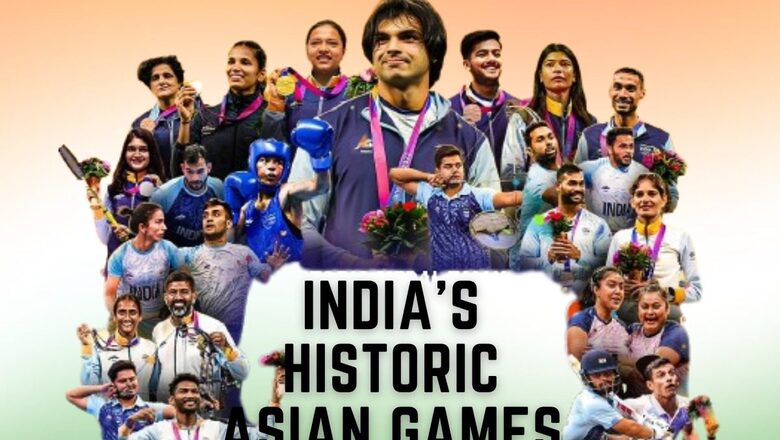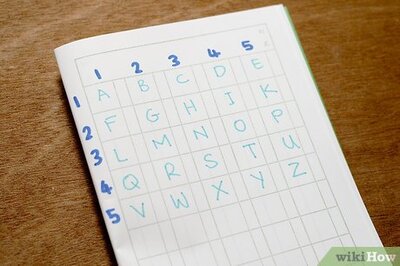Khel Vaani I After Hangzhou Show, India Should Invert Pyramid, Create Attitudinal Sporting Ecosystem

views
In my piece ‘Khel Vaani | India’s Sporting Journey: From Budapest to Paris via Hangzhou with Love’, I had three humungous wishes from the Hangzhou bound Team India- One, to rise above the incremental performance improvement and catapult to the stratosphere. The quantum jumps in the performance, at least in the Asian Games, need not be a pipe dream.
Two, because it is time create India’s own “Next Practices” and leapfrogging to break the jinx at Asian Games emulating the success of Chandrayaan-3.
Three, to make India a true sporting powerhouse, as a starter, the Indian team must aim big with a resolute conviction that nothing less than doubling the Jakarta Games medal tally of seventy would do.
What I asked for was a tall order- may be a pipe dream.
An Audacious Dream Comes True
Truth beckons that the above wish list of mines was just an audacious unachievable dream. And I have no compunction in saying that except the die-hard optimists, few in the country, including yours truly really believed that the slogan- ‘Hum Hain, Zidd Pe Sawaar, Iss Baar, Sau Paar, Phir Se, Hum Honge Kamyaab!’ will be actualized. Even Bhupinder Singh Bajwa, India’s Chief De Mission at Hangzhou admitted on the penultimate day of the competition “We came here with the target of 100 medals but didn’t imagine our dream would come true.”
And this takes me down to the memory lane to my childhood days when the sage India’s three times Prime Minister, Atal Bihari Vajpayee, gave me the dreaming mantra in 1969 “Bete Sapne Sitaron Ke Aage Ke Dekhna, Sapne Sach Hote Hain”.
Yesterday was curtain time of the two weeklong continental sporting extravaganza for India in the 19th Edition of Asian Games at Hangzhou, China, where a dedicated, disciplined, and passionate bunch of 655 athletes, ably guided by the determined Sports Federations and Administrators, trained by the best in the class coaches, supported by never tiring support staff and backed by the big-bang vision and full support of the Government of India, have made “Mission Impossible Possible”.
Hundred Par is Old-Fangled Clique Now
When on Saturday September 7, the women’s Kabaddi team defeated Chinese Taipei 26-25 in a thrilling final to clinch the Gold Medal, India climbed the never before tried the mount of the magical one hundred medals in the continental Asian Games. And with it, India joined the galaxy of famed four (China, Japan, South Korea, and India) as the Asian Sporting Powerhouse, who secured more than one hundred medals in the 19th edition of the Asian games.
The Day it Rained
October 7 was the penultimate day of the Hangzhou Asian Games and was the last day for India to add to their record medal tally. It also turned the most momentous one. It was a day when the Indian contingent, bagged 12 medals distributed evenly between men and women.
And what a day! It rained gold from all sides and the day entered in the folklore for future years as the one when within half a day Indians ran away with six Gold Medals. It is a feat not achieved in the past on a single day in any single edition of the history of the Asian Games with the squad returning home with six Gold Medals on a single day. Here it is:
One, The Indian duo Satwiksairaj Rankireddy and Chirag Shetty vanquished Choi Sol Gyu-Kim Won Ho of South Korea in straight sets 21-18 21-16, to bag the historical maiden Badminton doubles gold medal for the country. With the victory, the duo, ranked third globally also reached the pole position- Rank 1 in the world.
Two, what a sweet revenge it was. The Indian men’s Kabaddi team that had lost out to Iran in 2018 Jakarta Games, and settled for a bronze, roared back in a dramatic and cacophonous hour of dispute to defeat the reigning champion Iran 33-29 to reclaim gold.
Three, Cricket, the best team gets the Men Gold. In a rain marred match, the excitement of the outright win after Indian bowlers put Afghanistan on mat was robbed, But India the best team in the world across formats won the Gold.
Four, Kabaddi, as already mentioned above, the Women team won their third continental games Gold 26-25 against Chinese Taipei.
Five, Archery individual compound Men-what a final it was with two Indians Ojas Pravin Deotale and Abhishek Verma fighting for the gold. Ojas beat Abhishek Verma 149-147 to clinch men’s individual gold medal match while Verma bagged the silver.
Six, Archery individual compound women, Jyothi shows the way. Before Ojas Deotale, it was the golden day for Jyothi Surekha Vennam who defeated Chae-won of the Republic of Korea 149-145. And what a performance it was, Jyothi shot a nine on her first arrow, the 14 remaining arrows were all 10s, equalling the Asian Games record score.
Yeh Dil Mange More
But the Day 14 had just warmed up. It not only rained gold.
In wrestling, 24-year Deepak Punia romped home with a silver medal and the last two medals of the 19th Asian Games for India were capped by chess teams, where both the Men (comprising Rameshbabu Praggnanandhaa, Vidit Santosh Gujarathi, Arjun Kumar Erigaisi, Hari Krishna Pentala and Gukesh Dommanraju) and Women (featured Vantika Agrawal, Savitha Shri Baskar, Harika Dronavalli, Koneru Humpy and Vaishali Ramesh Babu) got Silvers. With this along with Abhishek Verma, it was silver medal number 4 for the day.
There were more to come, it was redemption time for Women’s Hockey that got bronze defeating Japan 2-1 with the goals scored by Deepika and Sushila Chanu. Compound archer Aditi Swami, beat Indonesia’s Ratih Zilizati Fadhly 146-140, to bag another bronze.
And it finally read 6 Gold, 4 Silver and 2 Bronze on the final day.
The 14 Days
Before the commencement of the 19th Edition of Asian Games, starting with 51 medals in the 1st Games in 1951 at New Delhi, India had won total 672 medals at the Asian Games, including 155 golds, 201 silvers and 316 bronze with its previous best being 70 medals in the Jakarta edition where it ended with 16 Gold, 23 Silver and 31 Bronze.
As India heads to city of Nagoya in Japan for 2026 Asian Games, it has added 107 at Hangzhou with 28 Gold, 38 Silver and 41 Bronze and total medals tally at Asia having swelled to 779 that comprises 183 Gold, 239 Silver and 357 Bronze.
Quite an accretion to the medal tally in one edition of the game.
Make no mistake, India entered 19th Asian Games as a rank outsider. At Jakarta, apart from Asian sporting power houses China, Japan and South Korea, the countries like Indonesia, Uzbekistan, Iran and Chinese Taipei all had performed better than India.
India entered the ring at Hangzhou wishing to be Asian Sporting nation and it has delivered with a bang.
Significance of India’s Performance at Hangzhou
What a metamorphosis it has been in “Woh 14 Din” just gone by?
It is worth noting that after securing 51 medals in the first Asian Games in 1951, in the next seven editions India’s medal tally did not cross 20. It was only in 1982 Asian Games in New Delhi that India’s medals crossed 50 once again with 57 medals. Doha was the first Asian Games that was held outside India where Indian team crossed 50 medals which was followed with 70 at Jakarta. Stupendous performance of 107 medals at Hangzhou is all the more special because it has come in the back yard of global sporting powerhouse China.
I also dare to bare that if it were not for a dozens of podium near misses and African sports persons participating as Asians from few Asian countries, India’s medal tally would have crossed 125. But it was not to be, and it is over to the next edition.
The Big Picture
The 19th edition of Asian Games is one that is replete with historic firsts for India with a strong return to podium in sports it had earlier missed, and one of memorable comebacks story. It is a saga of National Anthem playing for the first time at the conclusion of many events where it had not happened in past. This remarkable feat of Indian sports persons across disciplines, has taken India out of the mould of only cricketing nation and has solidified country’s position as a powerhouse in Asian sports, surpassing all previous records in a single edition of the quadrennial showpiece.
Here goes the big picture first:
• India’s Asian Games medal tally at Hangzhou is 107 medals – 28 gold, 38 silver and 41 bronze. This exceptional performance marked India’s greatest medal haul in a single edition of not only the Asian Games but any multinational sports competition
• Hangzhou marks India’s biggest-ever medals haul in a single edition of the Asian Games. It is better than the best ever.
• The Indian contingent won medals on every single day of the tournament. On October 1 and October 7, it rained medals for India- 15 and 12 with six gold on the last day.
• It has been best ever performance in Athletics – 29 medals against 20 in the previous edition.
• Indian shooters medal tally at 22 was better than their previous best of 14 at Doha 2006 and a poor 9 at Jakarta.
• Archery has given the third highest medals after athletics and shooting – 5-2-2 and it is refreshing because in the last edition archery had performed poorly with just two silver medals.
• India’s dominance in compound archery was exceptional as the nation secured all five gold medals, with Jyothi Surekha Vennam and Ojas Pravin Deotale achieving a rare treble.
• More than 30 athletes have won more than one medal, with rifleman Aishwary Pratap Singh Tomar and pistol shooter Esha Singh winning the most medals by a single athlete – 4 each.
Nari Shakti
The phrase Nari Shakti is currency of the season. As such it is instructive to note as to how the female sportspersons of the country have performed at Hangzhou. It is unsurprising that the performance of male sportspersons is stupendous with 52 medals. But what is incredible that with 46 medals, India’s female sportspersons have rocked on. And if we add the additional nine medals secured in mixed/open category, the performance of female sportspersons are on a par with if not altogether superior compared to the performance of male players. It is incredible achievement given that female sportsmen got just 28 medals in Jakarta Asian Games.
Straight to Paris
For many Indian sportspersons, Hangzhou was more than the mere quest for an Asian Games medal. It was also about their direct visa to the 2024 Paris Summer Olympics Games. And among many who clinched the Paris berth included men’s hockey team, Javelin Kishore Jena, and boxers Parveen Nikhat Zareen, Preeti, and Lovlina.
Broad-Basing of Medals
In the 2018 Asian Games at Jakarta, 570 Indian sportspersons participated in 31 disciplines and returned home with seventy medals in 18 disciplines. Contrarily, in the 2023 Asian Games, 655 participants in 35 disciplines secured unforgettable new benchmark of 107 medals in 21 disciplines standing neck to neck with Japan and Korea. India got 28 Gold Medals in 10 disciplines (8 disciplines in 2018) and 38 silver medals in 14 disciplines (11 disciplines) and 41 bronze medals across 14 disciplines.
The 19th Edition of Asian Games will be remembered not only for the century plus highest number of the medal hauls for India but also for a record number of women sportspersons at the podium and India securing many medals in disciplines where the country has either no or little sporting history.
If Neeraj Chopra and Kishore Jena brought Men’s Javelin Gold and Silver home, so did Anu Rani bring Gold in Women’s. Parul Chaudhary’s gold medal in the 5,000 metres race was India’s first in the event at the Asiad since it was introduced at the 1998 Games. And in equestrian, the dressage team produced a stunning performance to win the gold medal, while in the individual event, Anush Agarwalla won the bronze, another first.
Also, for the first time ever, India’s National Anthem was played at a medal ceremony in the badminton courtesy the duo of Satwik- Chirag winning the doubles gold medal. Aditi Chopra missed Gold by a whisker nonetheless became first to bring first medal in Golf for the country.
The list goes on.
Indubitably, Hangzhou edition of the Asian Games proved a class apart for India, with the broad-basing of podium finishers across disciplines. Also interesting was the broad-basing of age of podium finishers with roller skating bronze medallist Sanjana Bathula and double squash bronze medallist Anahat Singh, both 15, and 50 years younger compared to 65-year-old Bridge silver medallist Jaggy Shivdasani.
Athletics Shining
Out of the total 107 medals, Athletics accounted for the highest 29 medals tally, the best performance of the country so far in the continental games. The previous best was 20 at Jakarta in 2018.
The significance of the stellar performance in athletic lies in the fact that with the Paris Summer Olympics less than 300 days away, it comes as a shot in the arm for the country.
And what a match Kishore Kumar Jena was neck to neck with Neeraj Chopra with the latter getting Gold with 88.88 metre while Kishore Kumar Jena getting his historic silver with 87.56-metre throw. And Javelin thrower Anu Rani was not to be left behind. She won the gold medal in the women’s javelin throw with a 69.92 m throw thereby becoming the first Indian woman to win a javelin gold in Asian Games history.
Equally exciting to watch was Parul Chaudhary and Avinash Sable’s double podiums, Tajinderpal Singh Toor’s shotput title. Also, 4x400m relay teams’ success and Tejaswin Shankar’s national record-breaking decathlon silver were few of the many highlight moments in track and field.
And what a momentous memorable performance it has been for Indian men and women in the track and field games. For the uninitiated 65 athletes participated in track and field events and out of them 41 romped homes with medals. And if this was not enough, in the process, Indian athletes surpassed two Asian Games records, 3 National Records, five seasons best performance and seven personal best performances.
How has it happened?
Indubitably, behind such a stellar performance dedication there stands unparalleled devotion, years of toils and sacrifice of medal winners and their families, but few in the country will have a clue that Athletics Federation of India backed by the government provided exemplary on the field support to athletes in terms of 18 best of class coaches, 2 doctors and 3 physios, and 2 masseurs. Also, unlike the past where Indian contingents were used to be full of officials, the athletics team had bare minimum of two managers.
A Conversation with Adille Sumariwalla
To better understand the nuances of the performance of the Indian contingent in general and athletics in particular, I had a conversation with Adille Sumariwalla. For the uninitiated, Adille is an ex-Indian Olympian who participated in 1990 Moscow Olympics in one 100-metres sprint. Adille today is India’s top ranked sports administrator as the President of Athletics Federation of India. He is an appointed Member of the ‘Mission Olympic Cell’ by the government in preparation for the 2020 & 2024 Olympic Games. He is also one of the four elected Vice Presidents of the World Athletics.
Adille consented to have a conversation immediately after landing from Hangzhou. Below are the excerpts of the conversation –
‘When the hard work brings result, it feels very good, rather great’. To my question that having crossed the Rubicon of 100 medals and rushing towards the improbable 110 (it ended at 107), how Adille felt as a top administrator of the country, he was candid — “humbled and felt very good rather great”. He added further, “It is a great day for the country, dedication of athletes, coaches and support staff, immaculate planning and execution by Sports Federations and exemplary vision and long-term support of Government of India has brought the country to this day”.
Adille is also happy at the final outcome where there has been more broad-basing of medals with shooting doing very well and India doing exceptionally well in many disciplines where either it had zero or very little track record of past performance.
‘Hundred medals were always in the striking range’. When I asked did you think it was a mission impossible for India to clinch 100 medals at Hangzhou? Adille said “One hundred medals were always a distinct possibility, the only issue was whether India will reach there, cross it or miss it by a whisker. Indian contingent landed at Hangzhou with a vision, and mission of 100 medals and it is gratifying that it achieved the humungous target placed before it.”
‘Planning and execution holds the key’. When asked to get more than 100 medals (and more than 28 gold medals), what did India do differently this time? Adille had simple mantra of two words “planning and hitting the bull’s eye with top-notch execution”. He also reminded it has not come in a day, rather there is a decade long hard work and continuous support of the Central Government behind it.
‘Determination, Passion and Patience hold the key’. Much before Neeraj Chopra struck Javelin Gold at Tokyo Olympic, Adille is known to have told, India’s time for athletics gold at Olympics has come. With Paris Olympics being less than 300 days away, I asked Adille what his take from 29 athletics medals at Hangzhou is, his simple mantra was “determination, passion, and patience”.
His clear answer was “the hard work is showing”. Vision and extraordinary backing of the central government, exceptional planning and dovetailed effort of identifying disciplines, identifying, talent, nurturing them, providing them with best possible coaches is what is bringing the result today.
Adille rues few misses in both men and female events and presence of African players in garb of Asian countries, else the Athletics India would have got more than a dozen gold medals in athletics. Adille says Indian team has been learning fast from the past mistakes and disappointments.
‘Bonanza of two javelin throwers’. When asked to specially educate the readers about spectacular success in Javelin both in World Championship and Asian Games (Two gold and one silver) and how it happened, Adille was categorical — more focus, greater resources, best of coaches and support staff, opportunities provided to compete with the best outside India. And he is savouring the results today with two players consistently throwing javelin above 85 metres, 10 above 80 metres and 20 above 70 metres. It is time to spot talent and nurture them across disciplines which the federation is doing with extra ordinary backing of the government.
‘Proud moment just the beginning’. Adille’s biggest take from Guangzhou was he was ecstatic that with a contingent of 65 in athletics, 41 returned with medals. Whole team is back victorious with glory. Increased funding, immaculate planning, laser focussed execution, focused training plans and routine exposure trips outside India, where the athletes practise and compete, are reaping dividend.
Adille adds it is proud and humbling cathartic moment. But is just a humble beginning, and the future looks great with unflinching support of Prime Minister Narendra Modi.
Salute to the Country
At a time when cricket crazy India is hosting One Day World Cup, the nation led by Prime Minister Modi, who supports Team India and always dreams big and makes his dreams come true, is singing paeans of ‘India’s athletes’. All I will say on the occasion “Maa Tujhe Salaam” and exhort Team India that we have shown at Hangzhou that we can do it in Paris with the motto – ‘Sitaron Ke Aage Jahan Aur Bhi Hain’.
Time to Take India’s Own Practices to Next Level
I wrote on September 2 that the emergence of sporting icons in India is by chance, not by design. For most, it has been a tortuous solo journey with immense sacrifices by families. Out-of-pocket expenses by the family are simply humongous. There is no concerted action either at the macro or micro level to find and nurture sporting young talent. It is time for a change. The laundry list of urgently needed actions is long, here are some of them.
Postscript
For the long term, I continue to beg for the following mantras to be implemented:
• In the federal set-up, as per item 33, List 2 of the Seventh Schedule of the Constitution of India, “sports” is a state subject. There is an immediate need for an Amendment to the Constitution to bring “sports” to the Concurrent List if purposive action has to start.
• If the government has a dream of making India among the top five sporting nations of the world by 2047, when it celebrates 100 years of Independence, it needs massive, planned investment on a recurrent basis. There is no dearth of money in the country, but it is time to create a dedicated non-fungible, non-lapsable and non-transferrable “sports fund” through a dedicated levy on cigarettes and alcohol.
• It is about time that each state takes responsibility for nurturing at least one sport (bigger states two sports). It will have a cascading effect. If proof of the success of this method is needed, it is time to look at just two states — Odisha and Haryana. Odisha is transforming hockey in India and Haryana has developed as a wrestling powerhouse. Also, in developing and nurturing sporting talent, the corporate sector has an important role to play.
• When it comes to sporting infrastructure, India has hit the nadir. A massive, coordinated plan of time-bound development of world infrastructure with top-level coaches at ground level is the biggest imperative. And talking of sporting best practices infrastructure, it has to percolate down to census towns, blocks, and gram panchayat level.
• As per the Statista database, in 2021, India’s population in the 0-14 age group was 25.6%. It is this age group that has to be the target population for creating sporting icons.
• To play sports, make children fall in love with it and let all adults take ownership to make India a sporting great. Sadly, even after 75 years of Independence, India as a society do not let sports last beyond childhood and kill the sporting zeal with the long-entrenched wholly dated paradigm of “Padhoge, likhoge, banoge nawab; kheloge, kudoge, hoge kharab” (If you study hard, you will live like a king; but if you play sports, you will ruin your life).
• India has just shown it has all the ingredients to become a sporting nation. Take home from Hangzhou is that it is time to invert the pyramid and create an emotional and attitudinal sporting ecosystem concurrently with the infrastructure and financial ecosystem. And it is time to de-bureaucratise and depoliticise sports.
The author is a multidisciplinary thought leader, and works as President Advisory Services of Consulting Company BARSYL. He is a sports enthusiast, and writes opinion under ‘Khel Vaani’. Views expressed in the above piece are personal and solely that of the author. They do not necessarily reflect News18’s views.



















Comments
0 comment